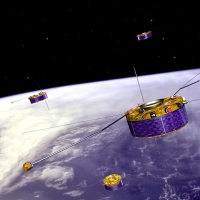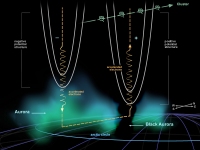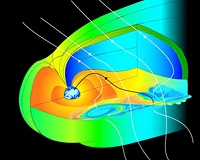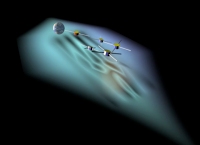10 years of success for Cluster quartet
6 September 2010
In the summer of 2000, four identical ESA spacecraft lifted off from Baikonur Cosmodrome at the start of the most detailed investigation ever of the interaction between the Sun and Earth. 10 years later, the Cluster quartet continues to unravel the secrets of the invisible particles and magnetic fields that envelop our Earth. |
| Illustration of the four Cluster spacecraft. Credit: ESA |
Launched into polar orbits which took them between
"Cluster is the first space mission with four identical spacecraft flying in formation to study this Sun-Earth interaction," said Matt Taylor, ESA's Cluster project scientist.
"Physical quantities, such as electrical currents, flow vortices and the motion of boundaries, can only be measured with a minimum of four spacecraft and Cluster's capability in this area has provided a leap forward in our understanding of the interaction of the solar wind with Earth."
As their orbits have evolved and the distances between them have altered, the spacecraft have been able to study in great detail many different regions of near-Earth space. During a decade of discovery, Cluster has provided numerous new insights into the fundamental processes that influence not only near-Earth space, but the Universe as a whole.
 |
| Illustration of black aurorae conditions. Credit: ESA |
One of the best known phenomena studied by Cluster is the aurora: red and green curtains of light that illuminate the upper atmosphere during long polar nights. Less well known is the 'black aurora', dark regions that punctuate the colourful northern and southern lights.
Cluster discovered that the dark patches correspond to 'holes' in the ionosphere that grow in size as more and more electrons shoot upwards into space. This is the opposite to what happens during a normal aurora, where electrons spiral down into the atmosphere and collide with ionospheric particles. Cluster found that all available electrons are 'sucked' out of the ionosphere within a few minutes. After that the black aurora disappears.
| Violent explosions on the Sun can lead to killer electrons in the near-Earth space environment. Credit: ESA (For larger versions of this video click here) |
Cluster was also able to make a key discovery about 'killer electrons', high-energy particles trapped in the outer Van Allen radiation belt. These particles move close to the speed of light and carry enough energy to penetrate satellite shielding and cause electrical shorts that can seriously damage vital components.
The breakthrough came when a particularly strong solar shock wave hit the magnetosphere in 2004. Over a period of 15 minutes, the spacecraft detected the transition from normal electron intensities to killer electrons levels. In the first stage of the process, electrons were accelerated by the shock wave compressing Earth's magnetic field. Then the magnetic lines wobbled, creating something like a very large-scale, low frequency laser, which further accelerated the electrons until they reached 'killer' energies.
| Artist's impression of a magnetic reconnection event. Credit: ESA (For larger versions of this video click here) |
One of Cluster's main tasks has been to monitor closely the conditions within Earth's magnetosphere, the invisible magnetic bubble which usually protects the planet from the particles arriving in the solar wind. A key process that takes place in the magnetosphere is 'magnetic reconnection', which occurs when energy stored in magnetic fields is released explosively. Understanding magnetic reconnection is a major quest in physics, since it plays a key role in numerous phenomena, such as star formation and solar flares, as well as experimental fusion reactors for electricity generation.
Cluster data led to the first 3-D picture of what happens at the heart of the process - the magnetic 'null' point. The new insights showed that the magnetic field can be twisted into 500 km-wide tubes.
 |
| Whirlpools of plasma in Earth's magnetosphere. Credit: ESA |
 |
| Oscillations observed in the magnetotail by Cluster and Double Star. Credit: ESA |
The spacecraft also solved a long-running mystery about how Earth's magnetosphere is constantly breached and replenished with charged particles. They discovered that giant whirlpools of plasma (electrically charged gas) can form as the solar wind slides around the magnetic bubble. Multi-point measurements made by Cluster reveal that these vortices reach
Computer simulations show that the vortices inject plasma into the magnetosphere by forcing magnetic reconnection to take place. This opens passageways that allow the particles to cross the usually impenetrable boundary of the magnetosphere.
Another breakthrough came when the Cluster quartet and a Chinese/ESA Double Star spacecraft were flying inside the magnetosphere at a time when its long, tapering tail was quivering. Detailed measurements by the satellites revealed that huge waves, more thanBecause of the geometrical arrangement of the satellites at the time, the oscillations were detected closer to Earth than ever before - only
Despite years of continuous exposure to the harsh radiation environment around Earth, all of the major systems on the four satellites are still functioning well. The mission has been extended until December 2012, subject to confirmation in late 2010, and there is a proposal under consideration to continue until 2014 . This means that it will have observed an entire solar cycle. Meanwhile, Cluster is being opened up to the wider scientific community after a recent announcement of opportunity for multi-instrument observations by Guest Investigators.
"During the last 10 years, the Cluster data have enabled many discoveries and breakthroughs in space physics, thanks to a very active scientific community and to free access to all high resolution data products," said Philippe Escoubet, ESA's Cluster mission manager.
"Cluster has driven the direction of how space physics will be studied in the future. Future Sun-Earth connection missions are all foreseen to be composed of multiple satellites."




